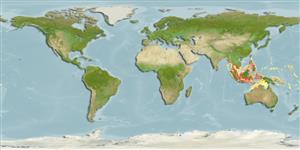Ελασμοβράγχιοι (καρχαρίες και σαλάχια) (sharks and rays) >
Myliobatiformes (Stingrays) >
Dasyatidae (Stingrays) > Urogymninae
Etymology: Himantura: Greek, iman, imantos = thong, strap + Greek, oura = tail (Ref. 45335).
Environment: milieu / climate zone / depth range / distribution range
Οικολογία
Θαλασσινό(ά) βενθικό(ς). Tropical
Indo-Pacific: off India, Indonesia, and Gulf of Thailand.
Μέγεθος / Βάρος / Age
Maturity: Lm ? range ? - ? cm
Max length : 120 cm WD αρσενικό/απροσδιόριστο; (Ref. 58048)
Short description
Μορφολογία | Μορφομετρία
This species is characterized by absence of skin fold on the ventral surface of the tail; quadrangular profile of disc; whip-like tail variably banded; adults' upper surface with widely spaced, honeycomb-like reticulations; juveniles with relatively large spots on disc (Ref. 58048).
Found inshore on soft substrates. Viviparous, with histotrophy. Few biological information is available, diet presumably consists of crustaceans and small fishes. Caught occasionally in demersal tangle nets; meat, skin (of high value) and cartilage are utilized (Ref. 58048).
Life cycle and mating behavior
Γεννητική Ωρίμανση | Αναπαραγωγή | Γεννοβολία | Αβγά | Γονιμότητα | Προνύμφες
White, W.T., P.R. Last, J.D. Stevens, G.K. Yearsley, Fahmi and Dharmadi, 2006. Economically important sharks and rays of Indonesia. [Hiu dan pari yang bernilai ekonomis penting di Indonesia]. Australian Centre for International Agricultural Research, Canberra, Australia. (Ref. 58048)
IUCN Red List Status (Ref. 130435)
Threat to humans
Harmless
Human uses
Περισσότερες πληροφορίες
Κοινά ονόματαΣυνώνυμαΜεταβολισμόςΘηρευτέςΟικοτοξικολογίαΑναπαραγωγήΓεννητική ΩρίμανσηΓεννοβολίαΣυναθροίσεις γεννοβολίαςΓονιμότηταΑβγάEgg development
Age/SizeΑύξησηLength-weightLength-lengthLength-frequenciesΜορφομετρίαΜορφολογίαΠρονύμφεςΔυναμική προνυμφώνΣτρατολόγησηΑφθονίαBRUVS
ΑναφορέςΥδατοκαλλιέργειεςΠροφίλ υδατοκαλλιέργειαςΣτελέχοιΓενετικήElectrophoresesΚληρονομικότηταΑσθένειεςΜεταποίησηNutrientsMass conversion
ΣυνεργάτεςΦωτογραφίεςStamps, Coins Misc.ΉχοιΣιγκουατέραΤαχύτηταΚολυμβητικός ΤύποςΕπιφάνεια βραγχίωνOtolithsΕγκέφαλοιΌραση
Εργαλεία
Special reports
Download XML
Διαδικτυακές πηγές
Estimates based on models
Preferred temperature (Ref.
123201): 27.9 - 29.3, mean 28.7 °C (based on 630 cells).
Phylogenetic diversity index (Ref.
82804): PD
50 = 0.5000 [Uniqueness, from 0.5 = low to 2.0 = high].
Bayesian length-weight: a=0.00832 (0.00366 - 0.01891), b=3.10 (2.90 - 3.30), in cm total length, based on LWR estimates for this (Sub)family-body shape (Ref.
93245).
Τροφικό Επίπεδο (Ref.
69278): 3.6 ±0.5 se; based on size and trophs of closest relatives
Fishing Vulnerability (Ref.
59153): Very high vulnerability (90 of 100).
